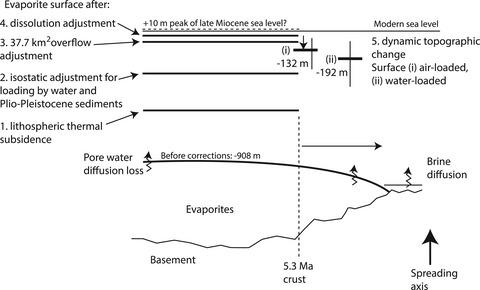当前位置:
X-MOL 学术
›
Basin Res.
›
论文详情
Our official English website, www.x-mol.net, welcomes your feedback! (Note: you will need to create a separate account there.)
Reconstructing the level of the central Red Sea evaporites at the end of the Miocene
Basin Research ( IF 3.2 ) Pub Date : 2020-09-20 , DOI: 10.1111/bre.12513 Neil C. Mitchell 1 , Wen Shi 2 , A.Y. Izzeldin 3 , Ian C. F. Stewart 4
Basin Research ( IF 3.2 ) Pub Date : 2020-09-20 , DOI: 10.1111/bre.12513 Neil C. Mitchell 1 , Wen Shi 2 , A.Y. Izzeldin 3 , Ian C. F. Stewart 4
Affiliation

|
Reconstructing the original depositional level of the Mesozoic and older c‘salt giants’ can reveal if their basins became filled to global sea level, but is complicated by dissolution, diapirism and because the time elapsed is so great. This is less of a problem in the Red Sea, a young rift basin that is transitioning to an ocean basin and where the evaporites away from coastal fringes are less affected by diapirism. In this study, we explore vertical movements of the evaporite surface of the central Red Sea imaged with deep seismic profiling, for the period of time after most evaporite deposition ended at 5.3 Ma (the Miocene‐Pliocene boundary). This boundary is readily mapped across the basin as a prominent reflection in seismic data correlated with stratigraphy at three DSDP sites. We quantify changes in the average elevation of the evaporite surface due to (a) thermal lithospheric subsidence, (b) isostatic loading by Plio‐Pleistocene sediments and water, (c) deflation needed to balance the volume of evaporites overflowing oceanic crust of 5.3 Ma age, (d) loss of halite by dissolution and (e) dynamic topography. Our best estimate of the evaporite level (−132 m air‐loaded or −192 m water‐loaded) lies below the range of estimated global sea level towards the end of the Miocene, suggesting that the basin remained under‐filled. If geological interpretations of shallow water conditions existing at the end of the Miocene (Zeit Formation) are correct, this implies that the water level of the Red Sea declined and was unstable. These calculations illustrate how spreading of evaporites can enhance thermal subsidence to cause rapid development of accommodation space above major evaporite bodies, which in the Red Sea case has remained largely unfilled.
中文翻译:

重建中新世末期中部红海蒸发层的重建
重建中生代和较早的c-salt巨人的原始沉积水平可以揭示出它们的盆地是否已被填满到全球海平面,但由于溶解,底辟作用以及经过的时间如此之长而变得复杂。在红海这个问题不大,红海是一个年轻的裂谷盆地,正在向海洋盆地过渡,那里的蒸发物从沿海边缘流失而受到的二叠纪影响较小。在这项研究中,我们探索了深部地震剖面成像后红海中部蒸发岩表面的垂直运动,这段时间是大多数蒸发岩沉积在5.3 Ma(中新世-上新世边界)结束之后的一段时间。该边界很容易在整个盆地上绘制出来,作为地震数据的重要反射,与三个DSDP站点的地层有关。我们对由于(a)岩石圈的热沉降,(b)上新世-新世沉积物和水的等静载荷,(c)平衡5.3 Ma的洋壳溢流的蒸发物的体积所需的通缩而量化的蒸发物表面平均高度的变化年龄,(d)因溶解而失去盐岩和(e)动态形貌。我们对蒸发岩水位的最佳估计(空气载荷为-132 m或水载荷为-192 m)低于中新世末期全球海平面的估计范围,这表明该盆地仍处于充填不足状态。如果中新世(Zeit地层)末端存在的浅水条件的地质解释是正确的,则表明红海的水位下降且不稳定。
更新日期:2020-09-20
中文翻译:

重建中新世末期中部红海蒸发层的重建
重建中生代和较早的c-salt巨人的原始沉积水平可以揭示出它们的盆地是否已被填满到全球海平面,但由于溶解,底辟作用以及经过的时间如此之长而变得复杂。在红海这个问题不大,红海是一个年轻的裂谷盆地,正在向海洋盆地过渡,那里的蒸发物从沿海边缘流失而受到的二叠纪影响较小。在这项研究中,我们探索了深部地震剖面成像后红海中部蒸发岩表面的垂直运动,这段时间是大多数蒸发岩沉积在5.3 Ma(中新世-上新世边界)结束之后的一段时间。该边界很容易在整个盆地上绘制出来,作为地震数据的重要反射,与三个DSDP站点的地层有关。我们对由于(a)岩石圈的热沉降,(b)上新世-新世沉积物和水的等静载荷,(c)平衡5.3 Ma的洋壳溢流的蒸发物的体积所需的通缩而量化的蒸发物表面平均高度的变化年龄,(d)因溶解而失去盐岩和(e)动态形貌。我们对蒸发岩水位的最佳估计(空气载荷为-132 m或水载荷为-192 m)低于中新世末期全球海平面的估计范围,这表明该盆地仍处于充填不足状态。如果中新世(Zeit地层)末端存在的浅水条件的地质解释是正确的,则表明红海的水位下降且不稳定。


























 京公网安备 11010802027423号
京公网安备 11010802027423号